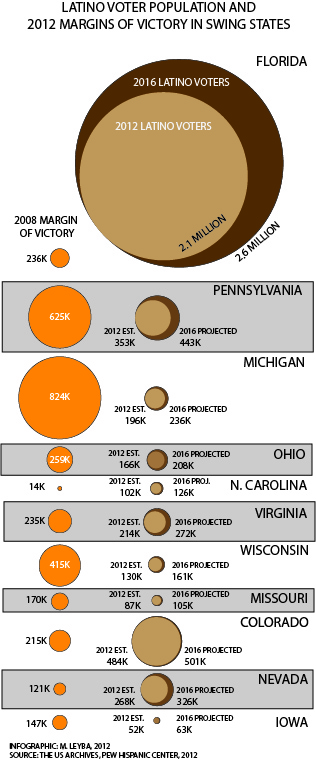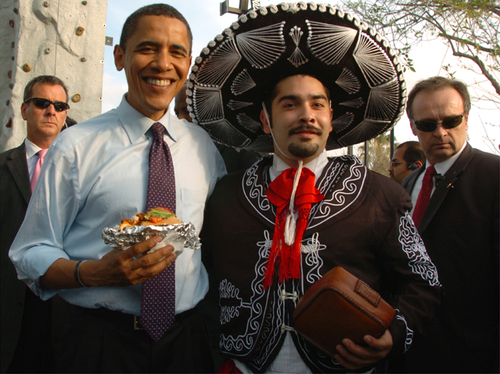Pandering is a time honored tradition in American politics, and the national party conventions this year are proof. The cast of speakers at the Republican National Convention were familiar: Mitt Romney, Jeb Bush, and Rand Paul among others; even more impressive was the lineup of Hispanic names alongside, including Governor Susana Martinez, Governor Luis Fortuño and First Lady Lucé Vela de Fortuño, US Senate Nominee Ted Cruz, and Senator Marco Rubio. Similarly, the Democrats matched the impressive arsenal of Hispanic politicians posited by the GOP, and broke new ground by having their first Hispanic keynote speaker, San Antonio Mayor Julian Castro. To boot, Los Angeles Mayor Antonio Villaraigosa presiding over the entire four-day convention.
Both parties are being anything but subtle in their attempts to make a strong appeal to Hispanic voters, and with good reason. While there are certainly few universal truths about all Hispanic voters, the sense of community within the Hispanic community is delicately tied to collective identity and common struggle. Appealing to this collective identity will play an important role in not only this particular election, and more importantly, in future ones too.
There are two schools of thought about why the terms Latino or Hispanic* have come to identify the broad collective of populations located across the American continents, parts of the Caribbean, and Europe. The first notion is that while Latinos share a wide variety of different ancestries and cultures, Latin-Americans have been boxed in with each other largely by way of outsider classification, or secondly, simply because it is easier to address one collective instead of dozens of individual ones.
Culturally, there are some political attitudes and priorities that span the collective, consistent political truths are few and far between. In fact, according to a recent study released by the Pew Hispanic Center, when asked how they identified themselves culturally, 2 out of 3 prefer to use their family’s country of origin (“Mexican,” “Cuban,” or “Dominican”), rather than the pan-ethnic terms (“Hispanic” or “Latino”). About 1 in 5 simply identify as American.
Identity is a contentious issue within the community because it is typically associated with certain social attitudes and motivators that span these cultures. For instance, Latinos, particularly immigrants, tend to be more optimistic in social and economic mobility. According to the same Pew study, 75% of Latinos believe they can get ahead through hard work alone (compared to 58% of the general public). Wealth stratification is off the charts in Mexico, Central and South American countries, so these populations view social mobility within the United States as more plausible than others.
Yet, while these types of attitudes pervade the voting bloc, there is also a notable layer of negative intra-cultural dynamics within this collective. This often manifests as animosity from one cultural community toward other cultures within the pan-Hispanic block based on perceptions of privilege and power. (For example, a native born Mexican or Guatemalan may feel more alienated by immigration policies than a Puerto Rican or Cuban would, as the latter are generally granted legal status more easily.) This is why campaigns use pan-ethnic terms as opposed to the powder-keg of narrowly targeted mono-culturalistic appeals in areas where these populations prevail.
The US has a long history of involvement in Latin American nations; it is also common for certain mono-culturalistic populations to perceive the US government differently than others. The stories of conquest done on behalf of the US are often passed through generations, including the political attitudes that are the result of them. For instance, Cubans that seek exile in the US do so in response to a dictatorial (and arguably oppressive) government, so those particular voters tend to lean more conservatively. The same can be said of Argentines escaping their government’s role in past economic turmoil.
As many seek asylum to flee these types of economic hardship and political turmoil, it follows that the foreign-born immigrant population has a more a optimistic outlook and more conservative leaning than their native-born counterparts. Geography is also a variable, because certain populations settle into culturally-concentrated areas, where they are more likely to be accepted or have some semblance of a social capital network. Needless to say, trying to cut across the entire pan-ethnic Hispanic voting bloc is not easy.
The 2012 Race
The basic idea of campaigning is to target constituencies, so it is no surprise that many campaigns have tried to target a Hispanic voting demographic to better appeal to these voters. Nationwide, pan-cultural Hispanics encompasses 16.7% of Americans, which is a large and lucrative payout for a well-targeted political campaign. In cutting across the pan-ethnic labels, the most common denominator is typically linguistic, with the exception of Brazil and a few Caribbean islands.
Consequently, there has been no shortage of Spanish-language (identity based) campaigns– Viva Bush, Adelante con Clinton, Juntos con Romney, and even ones like Latinos for Obama. In states with a concentrated Hispanic population, namely in the Southwest, even the most staunchly patriotic and xenophobic candidates have at minimum a Spanish-language print piece. The 2012 campaign is taking this linguistic appeal to a whole new level, although this strategy is proving increasingly difficult to undertake.
Now, more than ever, Spanish-language print media is encountering a sceptical eye. Explained by Rosario Dawson, co-chair of Voto Latino, “79% of Latinos consume their information in English… they’re on Twitter, they’re on Facebook, they’re on all different websites and they’re hearing what you’re saying about them in English and watching the same stuff in Spanish and going, ‘Wait a minute, you just said I was illegal a second ago, now you’re just trying to get my vote in Spanish?’ I think there’s a savviness to the Latino American voter.”
Navigating this maze is often difficult for both candidates in this race; Fmr. Governor Romney has been known as an advocate for ‘self-deportation,’ and believes that Arizona’s SB1070 is a model for the nation. President Obama makes exceptions for undocumented youth while leading an administration that has deported the most Latinos in history. It is becoming less plausible for campaigns to make a Spanish-language appeal without incorporating it into their broader English-language narrative.
At the beginning of September, the Commission on Presidential Debates announced its moderators, Jim Lehrer, Candy Crowley, Bob Schieffer, and Martha Reddatz. Unsatisfied with these moderators, the largest American-based Spanish-language network Univision, took the matter into it’s own hands. For the first time in history, Univision hosted a set of ‘Meet the Candidate’ forums, hosted by news anchors Jorge Ramos and Maria Elena Salinas, broadcast in Spanish. This forum brought to light issues that are of concern to the broad Hispanic community and addressed the discrepancies of policies between the English-language and Spanish-language sides of each campaign. Univision, pointed out these weaknesses and rejected the importance of running two separate campaigns, in favor for running a bi-lingual one, including the difficult step of synthesizing these ideas into the larger 2012 platform.
 There is a strong consensus that this presidential race will boil down to a group of 9 swing states: Florida, Ohio, North Carolina, Virginia, Wisconsin, Colorado, Iowa, Nevada, and New Hampshire. Combined, these states account for 110 of the 270 electoral college votes needed to win the election. Of these states, four have a particularly influential Hispanic voting base: Florida, Colorado, North Carolina, and Nevada. In each of these four states, the 2008 margin of victory was so small that Latino voters yielded enough power to swing the state in either direction. Virginia is slated to fall into this category in 2016, and Ohio not far behind.
There is a strong consensus that this presidential race will boil down to a group of 9 swing states: Florida, Ohio, North Carolina, Virginia, Wisconsin, Colorado, Iowa, Nevada, and New Hampshire. Combined, these states account for 110 of the 270 electoral college votes needed to win the election. Of these states, four have a particularly influential Hispanic voting base: Florida, Colorado, North Carolina, and Nevada. In each of these four states, the 2008 margin of victory was so small that Latino voters yielded enough power to swing the state in either direction. Virginia is slated to fall into this category in 2016, and Ohio not far behind.
Every election, Florida receives a lot of attention for being a high-stakes swing state. Both parties are accustomed to campaigning in this balmy climate, and for good reason: In 2008, President Obama won the state of Florida with only a 236,000 vote advantage over Senator John McCain. In 2004, President Bush won Florida with only 381,000 votes. This is an absurdly tight race in a state with a population of well over 18 million residents. Of these 18 million residents, 13.1 million are eligible to vote, and 2.1 million, or 16%, are Hispanic. Appealing to Hispanic voters in Florida is a centerpiece of any plausible statewide victory strategy.
Beyond Florida, a few states in the western region have come into play in the last few years. Over 20% of Colorado’s population is Hispanic which adds up to 484,000 people and yet its 2008 margin of victory was less than half of that number. Nevada is fairly similar with 27% of its population being of Hispanic descent; although Colorado and Nevada have relatively low yield in the electoral college. In contrast, North Carolina was such a tight race that one precinct could have swayed the election in either direction, yielding as many electoral college votes than Nevada and Colorado combined.
2016 and Beyond
If current population trends continue, the nation’s population will become more and more diverse. The nation’s population is projected to grow to 438 million people between now and 2050 – 82% of that growth will be as a result of immigration and their descendants. Non-Hispanic whites, who made up 65% of the population in 2005 will drop to 47% in the same time span. Hispanics will rise from 14% to 29% by 2050 and Asians and Asian-Americans will rise from 5% of the population to 9% in 2050. African-Americans will remain proportionally the same.
Furthermore, immigration is not flowing through the traditional places of years past. In the decade leading up to 2010, none of the counties with the greatest influx of Hispanic people are settling in the usually suspect states like California, Texas, Florida, New York; rather most are settling in the South and Midwest. Georgia has the highest growth rate, with Stewart County and Telfair County at 1740% and 842% Hispanic population growth respectively. Of the plausible swing states for that year, Wisconsin, Pennsylvania, Virginia, and North Carolina are all on the list.
To get a vision of the future of targeting geared toward Hispanic voters, look no further than New Mexico. New Mexico has historically been a text-book example of a swing state, but in recent years has become increasingly more Democratic. The reason for this is based in language – many of the Latinos in the state are native born first, second, or third generations, their news consumption is largely English. The normal strategies to appeal to Latino voters using Spanish-language advertising or advertising in the Spanish-language news has little on New Mexico’s Hispanics.
This is where the the synthesis of policy and culture is. While the right is being pulled further toward the Tea-Party fringe, they are alienating the larger block of voters they need to gain office. Unless this discrepancy is alleviated, there is little hope for capturing Western states. There are other recent factors that curb this influence.
Across the nation, restrictions on voting and identification requirement laws are affecting the native-born population’s access to polls. More importantly, approximately 10% of hispanic voters are displaced due to foreclosure since the last election. It is believed that many of these voters do not know about the requirement, or simply lack the voter motivation, to re-register to vote. Some not realize this until election day, resulting in a large number of unknowingly disenfranchised voters.
This will remain to be seen until after November 6th, and could turn out to either be devastating. Even still, the next four years is as important as ever- and like it or not, the Hispanic voting bloc is going to be influencing political discourse and policy more than ever before.
Michael Medina Leyba
Political Science ’13
*for the purposes of this article, the terms Latino and Hispanic will be used interchangeably.
Taylor, P., Lopez, M. H., Martínez, J., & Velasco, G. (2012, April 4). When labels don’t fit: Hispanics and their views of identity. Retrieved from http://www.pewhispanic.org/2012/04/04/when-labels-dont-fit-hispanics-and-their-views-of-identity/
The Huffington Post. (2012, October 05). Rosario dawson talks the untapped powers of latino voters on the gavin newsom show. Retrieved from
http://www.huffingtonpost.com/2012/10/05/rosario-dawson_n_1943115.html
Lopez, M. H., Gonzalez-Barrera, A., & Motel, S. (2011, December 28). As deportations rise to record levels, most latinos oppose obama. Retrieved from http://www.pewhispanic.org/2011/12/28/as-deportations-rise-to-record-levels-most-latinos-oppose-obamas-policy/
Politico. (2012, October 8). 2012 swing states. Retrieved from http://www.politico.com/2012-election/swing-state/
US Archives. (n.d.). 2008 presidential election. Retrieved from http://www.archives.gov/federal-register/electoral-college/2008/popular-vote.html
US Census Bureau. (n.d.). State and county estimates for 2008. Retrieved from http://www.census.gov/did/www/saipe/data/statecounty/data/2008.html
Lopez, M. H. (2008, November 05). The hispanic vote in the 2008 election. Retrieved from http://www.pewhispanic.org/2008/11/05/the-hispanic-vote-in-the-2008-election
Passel, J., & Cohn, D. (22, February 2008). Us population projections: 20
Pew Hispanic Center. (2012, April 16). Latinos by geography. Retrieved from http://www.pewhispanic.org/2012/03/16/latinos-by-geography/
Gonzales, A. (2012, March 7). Recent trends and challenges for the latino vote. Retrieved from http://www.wcvi.org/press_room/press_releases/2012/120308_study.htm



